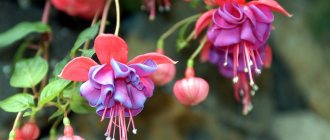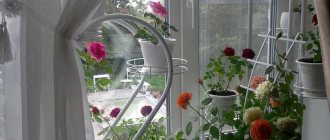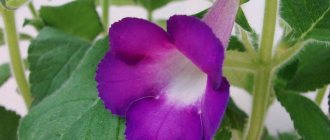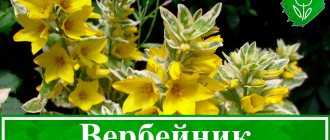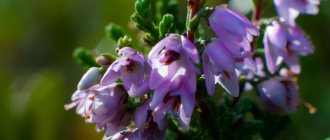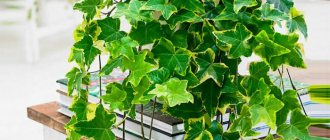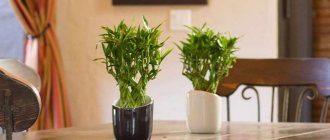Achimenes in nature and culture
In nature, exotics grow in the tropical forests of South and Central America. It belongs to the Gesneriaceae family and is a close relative of Saintpaulias, Streptocarpus and violets, popular among gardeners. Achimenes began to be grown as a cultivated plant in the 18th century. Today they decorate many gardens, greenhouses and home flower beds.
The beauty of the flowering of wild “brothers” of Achimenes can be observed all year round. At home, with proper care, the period of riot of colors lasts only up to six months, giving way to a state of rest.
These beautifully flowering perennials come in many varieties, differing in foliage shape, flower size and color. But they all have one thing in common - long creeping stems that effectively hang from the walls of the container, forming an openwork vertical carpet. Achimenes are famous for their abundant and lush flowering, which is replete with a wide palette of color shades.
Achimenes are among the heat-loving plants. This is indicated by the name of the culture, which when literally translated means “Achimenes” = “a” (no) + “chimenes” (cold).
Achimenes flowers: types, varieties
Achimenes is a beautiful indoor flower, very easy to care for.
Flower shapes have two types:
- Long pipe finish.
- Bowls with five blades.
Achimenes belong to the Gesneridae family, their closest relative is Gloxinia. Flower varieties are so diverse that they are further divided into groups:
- Height type:
- Erect (Erecta). They have tough shoots that shoot upward. Suitable for decorating window sills and shelving.
- Ampelous (Longiflora, Cattleya). Due to the presence of flexible shoots, the flowers seem to hang down. That is why they are often placed in hanging flowerpots.
- Flower size (diameter in parentheses):
- Small-flowered (up to 3 cm).
- Medium-flowered (from 3 to 4.5 cm).
- Large-flowered (over 4.5 cm). The most famous varieties are Rose, Kim Blue, Ring of Winsdor, Bright Rose.
- Flower type:
- Terry (Abendrot, Alter Ego, Bianco Natale).
- Simple (Aquamarine, Apple Cider, Argentina). Note that terry varieties began to appear quite recently. Breeder Serge Salibe took an active part in this process. Nuance! Simple varieties bloom more abundantly than double varieties.
- Color palette:
- Blue and light blue (Aquamarine).
- Pink and coral (Little Beauty, Pink Beauty).
- Red and scarlet (Master Ingram, Flamingo).
- Purple and lilac (Chiapas, Haage, Purple King).
- White (Juaregia, Schneewitschen, Snow Queen).
- Yellow and ivory colors (Yellow Beauty, Paul Arnold, Clouded Yellow).
Plants are seasonal, so it is extremely important to provide them with dormancy during the colder months. Flowering is long lasting, lasts from early summer to autumn
Popular varieties
Today, several varieties of Achimenes are distinguished in cultivation, on the basis of which dozens of varieties have been bred. The most popular among them are described below:
- Long-flowered - plants up to 30 cm high. The ampelous stems are decorated with slightly elongated pubescent leaves of light green color. Large flowers are located singly in the axils of the leaves.
- Large-flowered - bushes up to 60 cm high. Erect stems are decorated with large elongated leaves. Purple-red flowers are arranged in pairs in the axils of the leaves.
- Hybrid - forms created by crossing several species. The ampelous or erect stems are decorated with pointed, pubescent leaves with jagged edges. They are famous for the original colors of their flowers, which delight with their abundant blooms.
Plants can have both regular and double flower shapes. The color palette of shades is wide. It covers all shades, starting with light shades such as white, yellow, pink, coral, lilac, blue and ending with dark ones - violet and sea green.
A brief description of the most popular varieties of Achimenes:
- Blue Star - bushes with erect stems, decorated with large flowers with corollas of a violet-blue hue. The petals have interesting colors in the form of applied strokes.
- Peach Cascade - bushes with erect, slightly drooping shoots are decorated with spectacular peach-orange flowers with a yellow spot at the central point.
- Serge Saliba - bushes with erect stems, decorated with two-tone “stars” with a yellow core and pinkish edges.
- Glory are compact ampelous plants that delight with abundant blooming of spectacular flowers with a yellow core and scarlet petals.
- Double Pink Rose - lush flowering bushes with semi-double flowers of a pale pink hue, vaguely reminiscent of half-opened rose buds in shape.
- Purple King - bushes with erect stems, decorated with large lilac flowers with yellow speckled throats. The long-flowering variety pleases the eye from early spring to late autumn.
- Sauline - plants with erect stems, crowned with small flowers with jagged edges of an original lemon-purple color. Depending on the growing conditions, the color tone can change from yellow to pink.
- Lavender Fancy - ampelous plants with burgundy stems and light green foliage, decorated with simple flowers of striped creamy-brown color.
- Peach Blossom - ampel-shaped bushes. They are distinguished by spectacular foliage, the upper part of which has a dark green tint, and the lower part is burgundy. The flowers of the plant also include two shades: the center is decorated with a purple “eye”, the edges are pale pink.
What does Achimenes look like?
Achimenes (Achimene) is a perennial herbaceous plant no more than 30 cm high. The shoots of the bush are quite fleshy, the leaves have a glossy surface, an oblong shape and a dark green hue with clearly visible veins and jagged edges. The indoor plant is distinguished by the friendly appearance of several buds at once. The flowers are small and slightly shaped like a gramophone. The root system of Achimenes develops as rhizomes - bulbs, externally covered with small scales.
Achimenes
History of appearance
In the wild, the plant is distributed in Central America and Mexico. The first written mention of it was found in the scientific works of one of the biologists who studied the flora of Jamaica. A detailed description of the flower was compiled back in 1756.
How to grow at home
A guarantee of the beauty and duration of flowering of Achimenes is good care of the plant. If you follow simple maintenance rules, the flowering of the bush can be extended up to 6 months.
Soil composition
Achimenes is not particularly demanding in care. Light, well-drained, slightly acidic soil is best suited for its cultivation. To obtain the desired composition, two parts of leaf soil are mixed with one part of peat and sand.
Selecting a location
Achimenes are heat-loving plants. They feel most comfortable on windows facing south. During flowering, exotics are vulnerable to direct sunlight. With abundant light, their buds acquire a brown tint, and the colors become less bright and saturated. During this period, it is better to move them to a place with diffused light.
At the same time, you should avoid shaded areas. The fact that the exotic plant does not have enough sunlight will be indicated by stretching bare stems and crushed foliage.
Important point! You can determine how sun-loving a plant is visually: bushes with dark foliage need more light than those with delicate greenery.
Temperature
One of the key conditions for successfully growing achimenes at home is maintaining the temperature regime. During the period of active growth and flowering, the optimal temperature for exotics is varying between 22-24°C. In hot months, when the ambient temperature at night drops to +20°C, the bush can be safely left on an open balcony or veranda.
During the rest period, the temperature threshold can be lowered to +18°C. When preparing a plant for wintering, the temperature should be lowered gradually. This will allow the plant roots to gain the necessary substances before hibernation, thereby minimizing stress.
Humidity and watering
Heat-loving exotic requires regular watering. For this purpose, use water at room temperature, pre-settled for 24 hours. The delicate plant instantly reacts to cold water by developing brown spots on the leaves.
Watering is carried out only during the “awake” period of the bush, accompanied by active growth and flowering. The plant is watered as the earthen clod dries. During the dormant period, the flower is not watered at all.
Important point! It is necessary to water strictly at the root of the bush, minimizing the risk of moisture getting on the leaves and flowers.
Achimenes is a tropical plant by nature. It feels most comfortable when the air humidity is within 60%. For moistening, it is convenient to use trays with wet pebbles placed in close proximity.
Fertilizer application
During the period of growing green mass and abundant flowering, Achimenes needs regular feeding. For this purpose, complex fertilizers intended for beautifully flowering plants are used. Fertilizers are applied once every two weeks. The first time is fed a month after awakening and transplanting the bush.
The main thing is not to overdo it. The bush may react to excess fertilizer by dropping leaves.
Care errors and their elimination
The table contains frequently encountered problems when growing Achimenes and their elimination:
| Problem | Causes | Solution |
| Light brown spots on leaves | Watering with cold water | Use warm, well-settled water for irrigation |
| Changing the color of the buds | The indoor air is too hot | Observe the temperature regime, do not overcool or overheat the flower. |
| Small inconspicuous flowers | Nutrient deficiency | During the growing season, regularly apply complex fertilizers |
| Brown leaf tips | Dry air | Spray the space around the flower, place the flowerpot on a tray with wet expanded clay |
| Curling leaves | Soil waterlogging | Reduce the number of waterings |
How to transplant and prune a bush
Achimenes is replanted after each wintering at the end of the dormant period. Some gardeners successfully replant at the beginning of summer. Bushes are grown in containers with wide, low sides.
The procedure is performed in the following sequence:
- 30-60 minutes before replanting the achimenes, the container with the plant is watered abundantly.
- The rhizomes are removed from the pot and carefully cleaned of soil.
- The tubers are carefully inspected for damaged and rotten areas. If any are found, the sections are removed and treated with wood ash.
- The container is filled 1/3 with drainage, the role of which is played by sand mixed with vermiculite. The drainage is sprinkled with a layer of new soil mixture, on top of which a thin layer of sand is formed, and then the soil is again lined.
- Viable rhizomes of Achimenes - dark brown roots - are planted in a container with a new soil mixture, laying the roots at the level of the sand layer.
Important point! Treating and soaking the material in fungicidal compounds will help get rid of mold on the roots.
Some novice gardeners, in order to obtain a more variegated composition, plant several varieties in one container. It is not advisable to do this. Different varieties may differ in the speed of development. As a result: more powerful bushes will “oppress” the weaker ones.
Achimenes does not need pruning. The only exceptions are moments when young shoots build up green mass. In this case, to stimulate branching, they are pinched at the stage of the second and third leaves. The only “minus” of this pinching is the postponement of flowering by 2-3 weeks later.
How to store Achimenes rhizomes in winter
Achimenes can be harvested for the winter only after the above-ground part has died off. It will not fade or turn yellow, but will become completely dry.
Achimenes overwinter at temperatures not lower than 10 °C. They cannot be placed in the refrigerator. The optimal temperature during the resting period is considered to be 12 °C, but it is difficult to achieve it in a city apartment.
The flower survives well from year to year in warmer conditions. The main thing is not to place it near heating devices, or in a place with high humidity. Still try to keep it cool.
To preserve Achimenes rhizomes until spring at a room temperature of 18-20 ° C or higher, they need to be watered once a month. A little, so as not to wet, but only slightly moisten the surface of the soil. Otherwise, the rhizomes will dry out very much and may not wake up.
A temperature of 18-20 °C is far from optimal, and if it is higher, only a few of the largest rhizomes from the collection can survive if kept completely dry.
Overwintering of Achimenes in the ground
The easiest way to preserve Achimenes rhizomes is directly in pots in winter. They are placed in a cool, dark place. And they forget until February. Of course, if the winter is really cool. Otherwise, the pot needs to be watered occasionally and little by little.
Sometimes at the end of the season the rhizomes protrude from the substrate. They cannot be left open. A 1.5-2 cm layer of dry peat should be poured on top.
If you plan to plant flowers, it is not recommended to wait for the sprouts to peck. They are dug up in early February and moved to new pots.
The easiest way to store Achimenes rhizomes is in the same pot where they grew.
Storing rhizomes of Achimenes outside the ground
It is difficult to leave a large collection in pots for the winter - it is not clear where to put them. Of course, if there is an insulated loggia, balcony or barn where the temperature does not drop below 10 °C, there is no problem. Otherwise, you will have to dig up the rhizomes, wash them, rinse them in a fungicide solution, dry them, and place them in containers or bags with filler. And only after that send him to rest.
For storage you can use:
- clean dry sand;
- peat;
- fine perlite;
- vermiculite
Every month you will have to check the safety of the rhizomes, ventilate them, and, if necessary, remove or treat diseased ones. In February, Achimenes rhizomes are planted in fresh soil.
Achimenes stored in bags must be labeled
Methods for propagating Achimenes
To obtain new plants when growing achimenes at home, 3 methods of propagation are used: seeds, cuttings and rhizomes. Each of them has its own characteristics.
Seminal
For planting, well-ripened seed material is used. It is collected from green box houses formed at the site of the flower, ripened for 2 months. Seeds are sown in the period from the second half of February to the beginning of March, distributed over a soil mixture prepared on the basis of equal portions of leaf soil and sand.
The planting material is not sprinkled with anything on top.
The seeds distributed over the surface are irrigated with a spray bottle and covered with glass or film. This will create an optimal greenhouse effect for germination. The main thing is to maintain humidity conditions and regularly ventilate the planting.
The first shoots will appear in 2-3 weeks. At the stage of formation of 2-3 leaves, the seedlings are thinned out in order to provide sufficient space for the development of the roots of young plants. Strong bushes at the age of 2 months are planted in containers.
Cuttings
Cuttings are taken from young shoots. For rooting, wet sand is used, mixed in equal proportions with leaf soil. The cuttings are buried almost halfway into the soil mixture. To create a greenhouse effect, a “dome” is formed from a plastic bottle over the cuttings.
The rooting process lasts 2-3 weeks. During this period, it is important to regularly ventilate and moisten the planting material. After a couple of weeks from the moment of rooting, the plant can be transplanted into a full-fledged container for a permanent “place of residence.”
Growing from rhizomes
The easiest way to propagate Achimenes involves separating 1-2 viable rhizomes from the rhizome during transplantation. They are small bumps 5-40 mm long.
Achimenes rhizomes are planted in light peat soil mixed with baking powder. Parts of the rhizome are laid horizontally, covered with a layer of earth 15-20 mm thick on top. The container with planted rhizomes is moistened and placed in a bright, well-heated place.
How to grow Achimenes from cuttings
The most common way to increase the number of pots with achimenes is propagation by cuttings.
To do this, cut off the top shoot or side leaf from an adult plant and plant it in the ground under film or glass.
Cuttings need to be watered regularly, it is important that the soil is always moist
For intensive growth, use enriched leaf soil mixed with sand in equal parts. Also use growth stimulants or an additional heat source. After a month, the cuttings will get stronger and need to be transplanted to a permanent place.
Achimenes is an unpretentious plant that can decorate a home in winter and a garden plot in summer. It is enough to acquire one sprout of this beautiful flower to turn your home into a real garden filled with the bright colors of Achimenes flowers.
Procedures during the plant's dormant period
The dormant period for exotic plants begins in mid-October and lasts until early spring. During this time interval it is necessary to limit watering. Having been saturated with life-giving moisture, the roots of the plant prepare for “hibernation.” The above-ground part of the bush dries out halfway.
The owner’s task is to cut off the withered stems and place the container with the roots in a cooler place protected from sunlight.
At the beginning of spring, having noticed the first manifestations of the plant’s “wakefulness”, you need to place the pot in a lighted place. Extending daylight hours will contribute to faster and more complete development of the green pet.
Caring for Achimenes
In order for Achimenes to bloom on time and abundantly, they require suitable conditions and good care.
Lighting
The best location for achimenes will be a western or eastern window. In the south, it is better to shade the leaves from the sun during the daytime.
In the northern part of the house or in the back of the room, the shoots will quickly stretch out from lack of light, and flowering may be completely absent.
Temperature
Its heat-loving nature is reflected even in its name: from Greek “ahimenes” is translated as “afraid of the cold.” But the flower does not like heat either: the optimal temperature in summer is considered to be 20...22 °C.
At temperatures above 27 °C, the condition of the corollas worsens, they become smaller and change their color.
In winter, rhizomes are stored at a temperature no higher than 15 °C.
Priming
For fast-growing and abundantly flowering achimenes, soil nutrition is important. The soil should have good air permeability and a slightly acidic reaction.
Of the ready-made substrates, the composition for Saintpaulia has suitable characteristics, which can be supplemented with pieces of coal, moss and brick chips.
When preparing the soil yourself, you need to mix sand, peat and humus in equal volumes and add the same amount of leaf soil.
Before planting rhizomes, the soil is heated in the oven or frozen in the freezer to destroy pathogenic microorganisms and fungi.
Achimenes pot
The main part of the roots of Achimenes is located superficially, so the pot for the flower is chosen to be wide and shallow. For hanging varieties, any flower pot that is hung against the wall or placed on a high shelf is suitable.
The material of the pot can be anything, the main thing is that there are wide drainage holes at the bottom to quickly drain excess water.
Watering
Achimenes should be watered regularly, especially in the summer when there are an abundance of flowers. At least once every 3 days, moisten the soil with well-settled water slightly warmer than room temperature. Watering is carried out early in the morning or after sunset.
It is important to ensure that water does not get on the delicate leaves. If this happens, then immediately blot the drops with a paper napkin.
Feeding
Achimenes need constant feeding to survive. From the moment the rhizome germinates, liquid fertilizers for Gesneriaceae or any universal remedy for indoor plants are applied at least 3 times a month.
Until mid-spring, you can add fertilizers with a predominance of nitrogen, which will accelerate the growth of green mass. By summer, you need a mineral complex with potassium and phosphorus. Ready-made fertilizers for flowering plants are usually sold with this composition.
During flowering, the amount of fertilizing increases to weekly.
Advice! Experienced gardeners recommend adding fertilizer in a minimal dose during each watering, which results in even more luxuriant flowering.
Transfer
In order for the flower to have enough nutrition for the new season, it is recommended to transplant the rhizomes into a new substrate after wintering:
- In February, the rhizomes are removed from the soil and cleaned of damaged parts.
- You can use the same pot, cleaned and rinsed well with boiling water, or take a new one. Cover the bottom with drainage.
- Cover with soil almost to the top, leaving 5 cm free to the top edge of the container.
- Water and place the rhizomes horizontally, using slight pressure to deepen them by half a centimeter.
- Pour another 1–1.5 cm of soil on top and spray with a spray bottle.
The pot is placed in light at a temperature of 25 °C. Sprouts begin to appear after 2 weeks.
